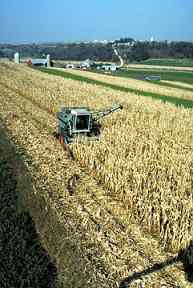|
|
 |
| Welcome | Getting Started | Resources | Site Map |
Week 2
High-Energy Feedstuffs |
Instructions for listening to audio clips
- Download the QuickTime Player to listen to the audio files.
- Read the QuickTime Instructions for installation help.
- Download the RealPlayer to listen to the audio files
- Instructions are on the RealPlayer download page
Corn
Time: 7.04
Follow along with the audio...
- Most important feed grain
- U.S. estimated production - 9,506 million bushels
- Regions of production – Midwest and Great Plains
- Figure 4.2 – Field of corn
- Most productive of grains
- Largest yield
- Estimated average yield – 138.2 bu/acre
- Greatest amount of digestible energy per unit of land
- Produces grain and stover
- Stover – all nongrain portions of plant
- Nutritional value of corn
- Table 4.2 – Average nutrient composition of corn
- Energy source
- High in starch
- High in oil
- Low in fiber
- Protein source
- Low CP content
- Quality
- Poor quality
- Low solubility
- Deficient in lysine, methionine, and tryptophan
- Lipid source
- High lipid content
- Increase energy and palatability
- Provide essential fatty acids
- Minerals
- Very deficient in Ca
- Moderate in P
- Bound as phytate complex
- Requires microbial phytase
- Vitamins
- Yellow grain
- Vitamin A precursors
- Fair source of E
- Poor source of D and B-complex
- Classified based on kernel
- Kernel – germ and endosperm
- Dent - major commercial variety
- Yellow or white
- U.S., yellow preferred
- Presence of carotenoids
- Carotenoids - group characterized by yellow to red pigments
- Figure 4.3 – Yellow dent corn grain on the cob
- Figure 4.4 – Yellow dent corn grain
- Many hybrids
- Hybrids – offspring of genetically dissimilar parents
- Facilitate growth in range of climatic conditions
- Genetic engineered
- Bt corn
- Control pest
- Round-Up Ready Corn
- Resist herbicide
- Nutritional value-added
- High oil
- Low phytate
- High lysine
- C3 and C4
- Based on intermediates of photosynthesis
- Three- versus four-carbon compound
- Characteristics of C4 compared to C3
- Heat tolerance
- Drought tolerance
- Efficiency of nutrient use
- Carbohydrate production
- Summer annual
- Plant in spring or summer
- Harvest in summer or fall
- Figure 4.5– Mechanical harvester harvesting grain
- Figure 4.6 - Mechanical harvester transferring grain
- Processing prior to feeding
- Increases nutritional value
- Processing
- Breaks kernel shell
- Increasing availability
- Break apart or gelatinizes starch granules
- Increasing digestibility
- No significant intrinsic toxins
- Susceptible to deleterious factors – molds, smuts, blights
- Fungi
- Characterized by mold
- Produce toxins called mycotoxins
- Examples of grain mycotoxins include aflatoxin, zearalenone, vomitoxin, and fumonisin
- Figure 4.7 – Aspergillus flavis on corn
- Feeding livestock
- General characteristics
- Digestible
- Palatable
- Cost-effective energy source
- Rarely, nutritional problems
- Swine and poultry
- Corn-soybean meal based are industry standard
- Adequate energy and protein
- Finishing beef cattle
- Increased weight gain, increased feed efficiency, and improved meat quality
- Lactating dairy cattle
- Support milk production
- Sheep
- Late gestation ewes and fattening lambs
- Generally, not fed to horses

Nutrient |
Average Composition,
% |
|---|---|
Crude protein |
10.4 |
Ether extract |
4.6 |
Crude fiber |
2.5 |
Ash |
1.4 |
NFE |
81.3 |
Starch |
72.2 |





| |
| Welcome | Getting Started | Resources | SiteMap |